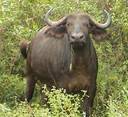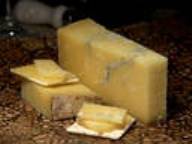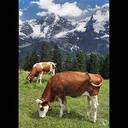Types of Cheese
Categorized by
Texture, Milk Source, Country of Origin
Ask any group of cheese experts and you probably won’t find a consensus about types of cheese or classification. Things can get very technical in the world of cheesemaking, so I’ll stick to a simple method of dividing cheeses into categories, and leave the technical details and arguments to others.
Types of Cheese by Texture
Every cheese has a texture that defines it. This texture refers to the degree of hardness, or to put it another way, how much moisture remains in the cheese when it is ready to eat. The method of manufacturing the cheese and the length of time it is aged will determine its texture and its degree of firmness. Cheeses which share some basic characteristics can be grouped together according to the following types of cheese:
1. Fresh
2. Soft-ripened or “bloomy rind” cheese
3. Washed-rind
4. Semi-soft
5. Semi-hard
6. Hard
7. Blue-veined
8. Double and triple crème
9. Pasta Filata (meaning spun paste)
Cheeses in each of the types of cheeses listed above will also share some taste characteristics and will be best suited for eating, cooking or grating.
Click here for more information on Cheese Textures and Examples
Types of Cheese by Milk Source

Cheese may have first begun with camel’s milk, goat’s milk or sheep’s milk, but today the majority of cheese comes, of course, from cow’s milk. Water buffalo, yak and even horse are also sources of milk for interesting cheeses. There are significant differences between cow's milk, goat's milk and sheep's milk...and as a result, the flavor, the tastes of these three types of cheese differ widely.

Goat's milk has less fat and tastes lighter. Goat's milk cheese tends to have a fresh, tangy taste. Sheep's milk contains the most butterfat and so sheep's milk cheese will taste much richer, even when it is fully aged and drier in texture. Both goat's milk and sheep's milk are richer than cow's milk, nutritionally speaking.

A surprising fact I turned up in my research revealed that the milk from Jersey cows contains more protein, more vitamins, more minerals and more butterfat (5-6%) than the milk from the industry standard breed Holstein cow (3-3.5% butterfat). (So buy Jersey cow milk when you can find it!)
When it comes to milk type, just as important as the animal source is the "terroir" where the animal is raised.

Terroir is a French word which encompasses everything from the region of the country, the local microclimate, the altitude, the rainfall, the types of grass and natural pasturage which the animal eats. It also refers to the season in which the milk was produced. Clearly, if a goat for example eats hay in winter...but in summer it grazes in an alpine pasture in France, eating everything from grass, moss, berries and branches to bushes, clover, herbs and flowers, then cheese produced from the goat's summer milk will taste far, far different from the cheese produced by its winter milk.
So cheese has seasons, just like the animals do (for reproduction) and the changing climate, season by season. There is a "best" time to make each cheese and a "best" time to eat that cheese (depending on the desired length of the aging process). It's important to keep this in mind when buying cheese.
Here are some examples. Goat cheese is usually eaten when it is young and quite fresh...2 weeks to 2 months old. So the ideal time to purchase goat cheese will be in late summer to early fall, because the milk will have been produced when the goat had the richest, most varied diet. An alpine cheese such as Morbier, which is produced from cow's milk, will be best consumed 3 or 4 months after it was produced. Therefore look for it in the cheese shop in November and December. Brie and Camembert will be at their peak in early fall, 1-2 months after they were made. The very hard cheeses like Parmigiano-Reggiano or a Pecorino Romano, are less seasonal and the quality is pretty uniform throughout the year.
A good rule of thumb to remember is that young, soft cheeses will taste best when purchased in late summer and early fall. The harder cheeses will generally taste best when purchased in winter, because they have been aged longer and come from milk produced the previous spring. Your local cheesemonger should be able to tell you the best seasons for the cheeses you would like to try.

One last point to make about milk. In the U.S., by law, ALL cheese which is aged less than 60 days, MUST be made from pasteurized milk. That applies to all cheese imported to the USA as well.
Most cheese lovers and cheese experts will agree that raw, unpasteurized milk makes the best, most flavorful cheese. Good examples are some of the Kings of Cheesedom - the royal Camembert de Normandie, Montgomery's Cheddar (English, 300 year history) or the Brie de Meaux.
Types of Cheese by Country of Origin
The most important cheesemaking countries are France, Britain, Italy, Spain, Denmark, Switzerland, the Netherlands and the United States. Of course cheese is made in many other countries as well. But until cheese and the craft of making cheese spread with trade and exploration beyond the shores of Middle Eastern and European cultures, cheese was almost unheard of in the Far East, in sub-Saharan Africa or in the Americas (pre Columbus days). Today cheese is consumed everywhere, but the real stars of the cheese world, the Kings and Queens of gourmet specialty cheeses, still come from the U.S., France, Britain, Spain, Italy, Denmark, Switzerland and the Netherlands.

As I discussed above in the section on milk, the terroir will have enormous impact upon the types of cheeses produced in each country. One example would be Alpine Cheeses, a distinctive type of cheese. Obviously alpine cheeses produced in mountainous eastern France or Switzerland, will differ greatly from a cheese produced in Normandy, located in western France bordering the Atlantic Ocean, for example. In fact some experts would say that a cheese produced in one small town will differ greatly from a cheese of the same type and name, produced in the next town! France is known to have more than 700 distinct cheeses, and there are still many more that do not have a specific name - they are simply local cheeses produced and eaten on the spot, so to speak.
President de Gaulle (France, 1890 -1970) is quoted to have said...."How can you govern a country which has 246 varieties of cheese?" A good question, but he understated the number of varieties!
In the 1960s Clifton Fadiman, an American writer, editor and New Yorker book reviewer wrote "A cheese may disappoint. It may be dull, it may be naive, it may be over-sophisticated. Yet it remains - cheese, milk's leap toward immortality."
I have created separate sections on this website, dedicated to the Best International Cheeses from Britain, France, Italy, Spain, Switzerland, Denmark and the Netherlands, as well as the Best American Artisanal Cheeses. There you will find a lot more information on specific cheeses, along with recommendations of my personal favorites as well as names of those cheeses which top most of the experts' 'Best of the Best' lists. Choices like these are necessarily subjective, but the research involved to make such recommendations is always fun, involving much nibbling and sipping of the appropriately paired wine!
HOME › Types of Cheese

Looking for something specific on GourmetCheeseDetective.com?
Enter your request below:
Follow The Gourmet Cheese Detective on Twitter: @The_Cheese_Tec
Make Your Investigation of Gourmet Cheeses a Memorable One With Our Gourmet Cheese Detective's Notebook:

As any good Detective knows, keeping a record of your investigations is a must! Use this concise caseophile's pocket notebook to keep track of your Gourmet Cheese discoveries. Record your favorite cheeses, keep memos of your travels in the world of Gourmet Cheese, and compare notes with the other Gourmet Cheese Detectives you meet! Click on the image above to order your Gourmet Cheese Detective Notebooks now! - G.C.D.